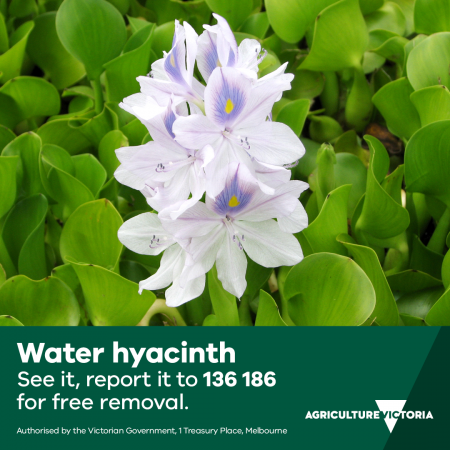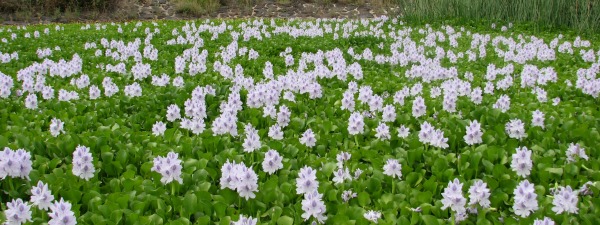Water hyacinth
Water hyacinth (Eichhornia crassipes) is a State prohibited weed. Read information about water hyacinth in non-English languages.
Please report by:
- completing this form
- calling our Customer Service Centre on 136 186
- emailing weed.spotters@agriculture.vic.gov.au
- if advertised online, emailing a screenshot of the advertisement to weed.spotters@agriculture.vic.gov.au.
Please do not attempt to treat or dispose of this weed yourself. We will treat, remove and dispose of water hyacinth safely, at no cost to the land owner.
Why you must report water hyacinth
Water hyacinth is one of the world's worst aquatic weeds. It infests rivers, dams, lakes and irrigation channels on every continent except Antarctica. It devastates aquatic environments and costs billions of dollars every year in control costs and economic losses.
Water hyacinth is native to the Amazon basin in South America and was brought to Australia in the 1890s as an ornamental plant.
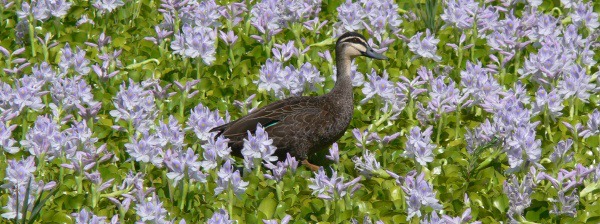
Identifying water hyacinth (video)
This is water hyacinth.
Water hyacinth has two sorts of stems, a long thin one and a bulbous stem that is filled with a sponge like material to help it float.
It has bright green, glossy leaves and flowers in summer that are mauve in colour with a purple patch on the top petal with a yellow spot in the centre of the patch.
Water hyacinth has dark purple feathery roots and creeping stems that root at the node to form daughter plants.
Water hyacinth has been found in waterways, garden ponds and dams and for sale illegally at markets and online.
Identifying water hyacinth (pictures)
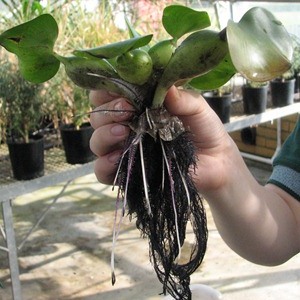
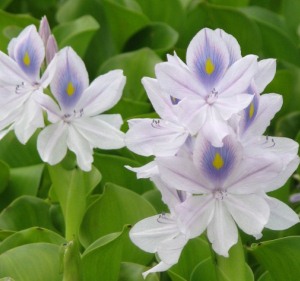
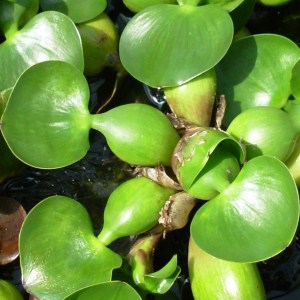
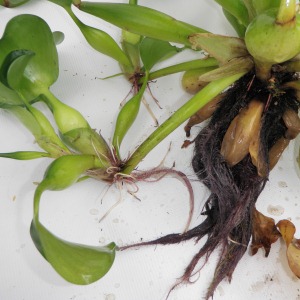
Water hyacinth is a floating water plant that can spread by daughter plants or seed. Water hyacinth plants have characteristic swollen stems with air filled tissue for buoyancy and large attractive mauve coloured flowers.
Bulbous stems contain air pockets, which help the plant to float. Stems can also be long and thin when the plants are crowded. Leaves are bright to dark green, smooth and glossy.
Water hyacinth flowers are mauve in colour, with a darker purple patch and yellow spot on the upper petal. A number of flowers will form on a single stalk in summer.
Water hyacinth has dark purple feathery roots.
Daughter plants grow from creeping stems that form roots at the nodes.
Water hyacinth activity sheets
These activity sheets are a fun way to learn about water hyacinth and its impacts. They may be useful in a classroom setting (for example in schools and English as a Second Language classes).
- Colouring by number
 [PDF File - 417.6 KB]
[PDF File - 417.6 KB] - Colouring by number
 [MS Word Document - 296.4 KB]
[MS Word Document - 296.4 KB] - Spot the difference
 [PDF File - 353.3 KB]
[PDF File - 353.3 KB] - Spot the difference
 [MS Word Document - 1.1 MB]
[MS Word Document - 1.1 MB] - Word find
 [PDF File - 133.9 KB]
[PDF File - 133.9 KB] - Word find
 [MS Word Document - 161.3 KB]
[MS Word Document - 161.3 KB]
3D model
Water hyacinth 3D model
The New South Wales Department of Primary Industries has developed 3D (three-dimensional) models to help people become more familiar with prohibited invasive plants, including water hyacinth, by providing a lifelike representation.
The model can be manipulated and inspected at every angle and magnification and is a great way to become more familiar with water hyacinth.
© Regional NSW through NSW DPI Invasive Species Biosecurity. Model created by Rachel Klyve.
Explore 3D model